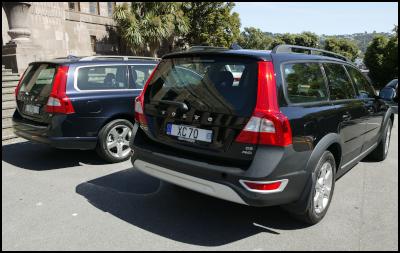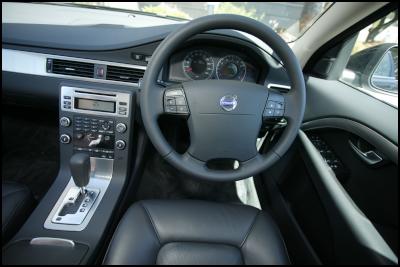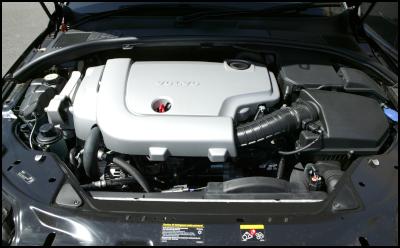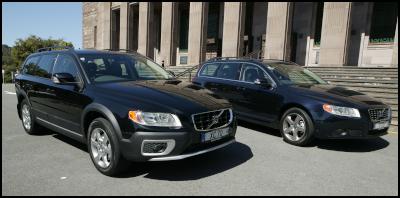MOTORNET: Solid citizens
MOTORNET: Solid citizens
Volvo V70/XC70 car review
SCOOP MOTORNET with Karl
Ferguson
Images by Neil Mackenzie - onlinefotos.com/neil
There are times when technology, rather than aiding us, seems frankly more inhibiting than anything else. It was this thought than ran through my mind after a few days with Volvo’s latest offerings. Despite a week respectively with both the V70 and its brethren the XC70, the electronic park brake continued to provide me grief. Was it pull on, push off, or the other way around? More importantly, whatever happened to the good old fashioned handbrake? And why can’t technology be both intuitive and a step forward?
The good news is that when it comes to Volvo’s newest set of twins, the park brake represents just about the only niggle of any note – surely not a bad thing. I have long been a fan of Volvo’s handsome wagons and sedans, and while the latest design iteration could be labeled just evolutionary, for such large cars, they cut a dynamic and attractive profile. Both share design cues with the recently released S80 sedan – such as the larger corporate grille – but it is the XC70, or cross over, all-wheel drive wagon that has made the largest leap. While it still retains the moulded bumpers of the previous model, these are better incorporated into the design and the overall look is more cohesive. And while it achieves reasonable ground clearance and is still quite a tall car, it doesn’t appear quite as elevated as the old model.
Apart from the ride height, style detailing and the XC70’s AWD ability, the two vehicles are virtually identical. It would be easy to dismiss these Volvos as simply load carriers – in this respect, both have a strong card to play – and it’s one of the obvious traits that will ensure their market appeal to those with large families and those with equally sporty pursuits. The interior is cavernous and the backseats will happily accommodate three adults, even across long distances. The depth of the boot is impressive, while the width of the vehicles is such that large items are easily managed. As expected, the backseats can be manipulated every which way and will lie flat to ensure even the largest and bulkiest items are able to be transported.

Click for big version
The interior is typically Volvo – large and comfortable leather clad seats, clear and easy to use controls and dials, and first rate fit and finish. The quality of the materials is what we have come to expect over recent years, and nothing disappoints. The brushed aluminium style inserts help ensure the interior feels both modern and user friendly.

Click for big version
Punters can option either a 3.2 litre petrol powered six cylinder, or a 2.5 litre, five cylinder turbo diesel (or the top of the range turbocharged T6). My guess is that diesels will be the model most rolling off showroom floors, which is a shame in some respects, as the petrol six is a real honey. Both test cars were very new and had limited miles on the clock, but even as tight as it was, the petrol engine impressed. Power delivery was silky smooth, the automatic kicking down responsively when acceleration was required. Keep in mind that these wagons don’t come light – both weigh in at between 1800 and 1900kg respectively. The petrol’s 175kW and 320Nm of torque did a good job of hustling the barely disguised mass.

Click for big version
The 125kW diesel meantime is solid, offering good levels of performance and sophistication. There’s no disguising it’s a diesel on start up, but it remains relatively quiet compared to some competitors. Torque is an impressive 400Nm ensuring it will serve as a good tow car, while acceleration from standstill to 100km/h is achieved in a respectable 9.5 seconds (the petrol manages the same sprint in 8.4 seconds).
On the road, both cars display good grip, and pretty predictable styling traits for large front drive or all-wheel drive vehicles. Personally, I found the steering on both models a little on the light side, and lacking in the ‘feel’ department. Not surprisingly, the V70 is the choice when it comes to hustling through corners. The XC70 tries hard, but its higher centre of gravity and soft suspension ensures that while it continues to provide confidence, it suffers from body-roll when really pushed through corners, somewhat diminishing any enthusiasm for hustling through the twisty stuff.
The soft suspension certainly ensures a plush ride though, and despite a bit of tyre noise in the XC70, both impress in this department – luxurious and comfortable are adjectives that spring to mind. Equipment wise, both come with plenty of kit as you might expect. Even so, I was a little surprised by the absence of a CD stacker as standard, and for such a large vehicle, parking sonars standard only on the rear and not the front. Having said that, pricing is fairly competitive when you compare it to similarly priced German offerings and the aging Saab 9-5. The V70 3.2 retails for $69,990 while the XC70 is another $10k. The diesel adds a further $5k premium again – no doubt ensuring prospective owners won’t dismiss the petrol versions lightly.
It would be easy to dismiss these Volvos as just the latest iteration of the tried and true in Volvo’s range of large wagons. And while it’s true that neither achieves anything dramatically new, both are supremely comfortable, well equipped, and competitively priced. More importantly, both make compelling arguments as to why a well sorted wagon will run rings around a more expensive and heavier SUV. Solid citizens they may be, but style and grace comes standard. If only they could fit a conventional handbrake for the New Zealand models…sigh.



 Binoy Kampmark: Junk Science And Bad Policing - The Homicide Prediction Project
Binoy Kampmark: Junk Science And Bad Policing - The Homicide Prediction Project Keith Rankin: Rational Expectations, Intelligence, And War
Keith Rankin: Rational Expectations, Intelligence, And War Peter Dunne: Dunne's Weekly - Is Andrew Little Wellington's Mayor-In-Waiting?
Peter Dunne: Dunne's Weekly - Is Andrew Little Wellington's Mayor-In-Waiting? Gordon Campbell: On Peter Dutton’s Fading Election Prospects.
Gordon Campbell: On Peter Dutton’s Fading Election Prospects. Binoy Kampmark: Withdrawal Symptoms - Hungary, Europe And The International Criminal Court
Binoy Kampmark: Withdrawal Symptoms - Hungary, Europe And The International Criminal Court Martin LeFevre - Meditations: No Silver Lining, Just An Opening
Martin LeFevre - Meditations: No Silver Lining, Just An Opening